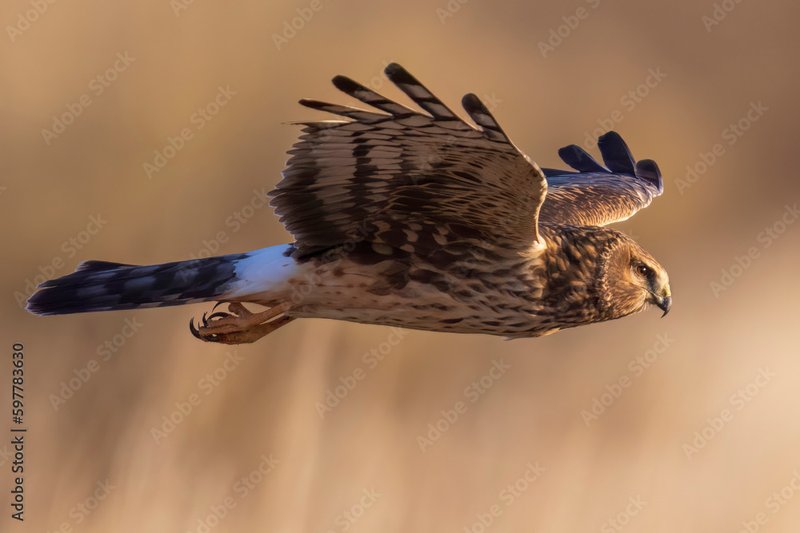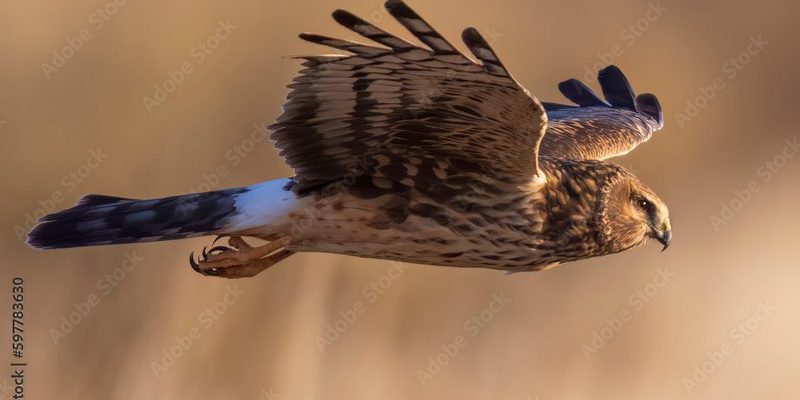
The Northern Harrier is a fascinating bird of prey that captures the imagination of bird watchers and nature lovers alike. Known for its graceful flight and keen hunting skills, this hawk is a master of the wetlands and grasslands where it thrives. Often seen gliding low over fields and marshes, the Northern Harrier has a unique appearance and behavior that sets it apart from other raptors.
Imagine watching a skilled acrobat perform. That’s what it’s like to see a Northern Harrier in action. With its long wings and distinctive flight pattern, it swoops and dives, searching for its next meal. This bird is not just about looks; it plays a crucial role in the ecosystem, helping to keep populations of small mammals and birds in check. If you’ve ever been curious about these majestic raptors, you’re in for a treat!
Physical Characteristics
The Northern Harrier is a medium-sized hawk, exhibiting a variety of features that make it both standout and elegant. Adult males typically sport a gray plumage, while females are larger, with a brown and streaked appearance. One of the most striking features is the characteristic white rump, which is easily visible when the bird flies overhead. This white patch is like a flag, helping bird watchers identify the species from a distance.
In terms of size, adult males usually measure about 16 to 20 inches in length, while females can reach a length of up to 24 inches. The wingspan is impressive too, stretching between 38 to 46 inches. This large wingspan allows for graceful gliding, a hallmark of the Northern Harrier’s hunting style. You might notice its long, slender legs, which are perfectly designed for snagging prey as it skims over the ground.
Another interesting trait is the Northern Harrier’s unique facial structure. They have a facial disc, similar to that of an owl, which helps them to locate sounds. This adaptation is particularly useful at dawn or dusk when the lighting conditions change. So, next time you see one of these birds soaring in the sky, appreciate its beauty—not just as a hunter but also as a master of its habitat.
Habitat and Range
The Northern Harrier favors open areas where it can hunt effectively. You’ll often find them in wetlands, grasslands, fields, and even coastal marshes. They prefer habitats that provide ample cover, such as tall grasses and shrubs, where they can stalk their prey. These habitats are not just homes; they are vital ecosystems supporting a variety of plant and animal life.
Geographically, the Northern Harrier has a broad range. They breed across North America, especially in the northern regions, and migrate south during the winter months. Their wintering grounds extend down to the southern United States and parts of Mexico. This migratory behavior not only helps them find food but also plays a significant role in maintaining healthy ecosystems along their travel routes.
The choice of habitat also affects their hunting strategies. In low, open spaces, they can use their sharp eyesight to spot movements in the grass. This adaptability makes them successful hunters, able to thrive in a variety of environments. Witnessing a Northern Harrier in its natural habitat is a reminder of the delicate balance between wildlife and their ecosystems.
Diet and Hunting Behavior
The diet of the Northern Harrier primarily consists of small mammals, birds, and even some reptiles. During the breeding season, they primarily hunt voles and other small rodents that abound in their grassland habitats. They are known to be opportunistic hunters, meaning they will take advantage of whatever is readily available. If you’ve ever seen a harrier swoop down with precision to catch its prey, you understand how skillful and adaptable these birds are.
Hunting is usually done by flying low over the ground, scanning for movement. This behavior is reminiscent of a stealthy predator, waiting silently before making a swift dive. The Northern Harrier’s wings are designed for soaring and gliding, enabling it to cover vast distances without expending too much energy. You might be surprised by how quietly they approach their prey. Their unique technique allows them to catch unsuspecting animals off guard, ensuring a successful hunt.
Interestingly, they also have a special behavior known as “bouncing.” During the hunt, Northern Harriers often hover momentarily before diving, which can confuse their prey. This hunting technique showcases their intelligence and ability to adapt in the wild. Their role in the ecosystem goes beyond just being a predator; they help control populations of various species, making them a vital part of their environment.
Breeding and Nesting
When it comes to breeding, Northern Harriers are quite interesting. They usually mate for the breeding season, which occurs from late March to early August. During this time, males perform aerial displays to attract females, showcasing their flying prowess. It’s a bit like a dance, where the male shows off his skills to impress the female. Once a pair is formed, they work together to establish a nesting territory.
Nesting usually takes place on the ground and is often hidden among tall grasses or dense shrubbery. The female typically lays between 3 to 6 eggs, which are incubated for about 30 days. After the chicks hatch, both parents play a role in caring for them, bringing food and protecting them from predators. It’s a heartwarming aspect of their lives, showing how these birds nurture their young until they are ready to fledge.
The fledgling stage is crucial, as the young harriers need to learn how to hunt for themselves. Parents often continue to feed their young even after they leave the nest, allowing them time to develop their skills. This nurturing behavior is essential for their survival and reinforces the bond between parent and chick. Observing this aspect of the Northern Harrier’s life cycle can be both inspiring and educational.
Conservation Status
Like many species, the Northern Harrier faces various threats that impact its populations. Habitat loss due to agriculture, urban development, and wetland drainage are significant challenges. This has led to a decline in suitable environments for nesting and hunting. Conservation efforts are essential to ensure the survival of this magnificent bird. Many organizations focus on protecting wetlands and grasslands to help restore the habitats that harriers need to thrive.
In addition to habitat loss, the use of pesticides can affect the Northern Harrier’s food sources. As they primarily hunt small mammals, any decline in rodent populations due to pesticide use can impact their survival. Awareness and advocacy can play a crucial role in protecting these birds, as educating the public about their importance helps foster support for conservation initiatives.
Fortunately, the Northern Harrier is listed as a species of “Least Concern” by the International Union for Conservation of Nature (IUCN); however, local populations may still be vulnerable. People can contribute by participating in conservation efforts, volunteering with local wildlife organizations, and advocating for policies that protect their habitats. Together, we can ensure that future generations can enjoy the beauty and ecological role of the Northern Harrier.
Interesting Facts
| Common Name: | Northern Harrier |
| Scientific Name: | Circus cyaneus |
| Size: | 16 to 24 inches |
| Wingspan: | 38 to 46 inches |
| Weight: | 0.5 to 2 lbs |
| Diet: | Small mammals, birds, and reptiles |
| Habitat: | Wetlands, grasslands, and fields |
| Life Span: | 3 to 5 years in the wild |
| Migration: | Seasonal migration to southern U.S. and Mexico |
FAQ
What does a Northern Harrier look like?
Northern Harriers are easily recognizable due to their distinctive physical features. Males are mostly gray with a white rump, while females are brown and streaked. Their long wings and tail help them glide gracefully over fields. Additionally, their unique facial disc aids in hearing, making them skilled hunters.
Where can you find Northern Harriers?
You can find Northern Harriers in open areas across North America. They thrive in wetlands, grasslands, and agricultural fields. During the breeding season, look for them in northern regions, while in winter, they migrate south to areas like the southern U.S. and northern Mexico.
How do Northern Harriers hunt?
Northern Harriers have a unique hunting strategy. They fly low and slow, using their keen eyesight to spot prey in the underbrush. They often hover for a moment before swooping down to catch small mammals or birds. This method allows them to sneak up on their prey, making them effective hunters.
Are Northern Harriers social birds?
Generally, Northern Harriers are solitary birds, although they can be seen in small groups during migration or in wintering areas. During breeding season, they maintain a territory and usually hunt and nest separately. However, they may be observed hunting in the same area if resources are plentiful.
How long do Northern Harrier chicks stay with their parents?
Northern Harrier chicks typically fledge around 30 to 40 days after hatching but may stay with their parents for several weeks afterward. During this time, the parents continue to provide food as the young birds learn to hunt on their own. This nurturing phase is crucial for their survival as they transition to independence.
What threats do Northern Harriers face?
Northern Harriers face several threats, including habitat loss due to agricultural practices, urban development, and wetland drainage. Additionally, the use of pesticides can reduce their prey populations. Conservation efforts focused on protecting habitats are vital for their continued survival.
Can I attract Northern Harriers to my backyard?
Attracting Northern Harriers to your backyard is challenging since they prefer open habitats for hunting. However, providing native plants and maintaining a natural landscape can help support local wildlife, including smaller birds and rodents, which may, in turn, attract harriers looking for prey.
Do Northern Harriers mate for life?
Northern Harriers do not mate for life. They typically form a pair bond for the breeding season, but after raising their young, they go their separate ways. The male displays aerial acrobatics to attract the female, and once they mate, both parents take part in raising the chicks.
How fast can a Northern Harrier fly?
Northern Harriers can reach speeds of up to 30 miles per hour when flying. However, their hunting style relies more on their ability to glide and hover than on high-speed pursuits. This allows them to cover ground while searching for prey efficiently.
How do I identify a Northern Harrier in the wild?
To identify a Northern Harrier, look for its distinctive long wings, white rump, and low gliding flight pattern. During breeding season, males will have a grayish appearance, while females are brown and streaked. Watching for their unique hunting behavior, such as hovering, can also help with identification.

